Ash Dieback Resistance Emerges – What This Means for Deer Management?
- Dan Beardsmore

- Jul 7
- 2 min read
There’s a flicker of hope for one of Britain’s most iconic native trees. According to scientists at Kew Gardens and Queen Mary University of London, young ash trees in parts of the UK are evolving genetic resistance to ash dieback—a fungal disease that’s devastated woodlands across Europe.
Up to 85% of ash trees have been lost in some areas, leaving entire landscapes scarred and woodland ecosystems unbalanced. For those of us who spend time in these woods—managing deer, observing nature, walking the ground—this is more than a scientific headline. It’s part of a broader story unfolding in real time.

What’s Happening?
Researchers have identified evidence of polygenic evolution, a process where small genetic changes across thousands of points in a genome build resilience over time. It supports a theory proposed over a century ago—nature, it seems, is adapting in response to the pressure of the disease. And fast.
This is encouraging. It means natural selection may be offering us a lifeline. With support from targeted breeding programmes and genetic research, there’s now a chance to help these young, resistant ash trees rebuild what has been lost.
Why It Matters for Deer Stalkers & Woodland Managers?
For deer stalkers and woodland managers, it’s a reminder of how dynamic our landscapes are — and how the natural world can, in some cases, start to fight back.
Ash trees form a critical part of lowland woodland structure—offering both biodiversity and seasonal food sources for deer. The loss of ash over the past decade has altered light levels, ground flora, and shelter in many areas, changing how deer behave and move. In unmanaged woods, open canopies can lead to thick regeneration of non-natives like rhododendron, adding pressure to an already complex environment.

Ash dieback is very much a live issue on the ground. As trees succumb and fall, it creates structural change in the woodland — more canopy gaps, more light on the woodland floor, and with it, a burst of regeneration and ground cover. For species like Muntjac, this is perfect: they thrive in dense, low-level cover. In this way, ash dieback has perhaps unintentionally accelerated the creation of habitats that favour them.
So, while the headlines are about disease and recovery, the reality on the ground for us deer managers is one of evolving and shifting habitat dynamics—understanding these shifts is vital.
Resistant ash could help restore balance and reduce reliance on costly replanting schemes with unfamiliar or non-native species. It’s also a small but powerful reminder that resilience in woodlands matters—and not just for timber value or carbon credits. It matters for ecology, wildlife, and the people who manage these places on the ground.
Final Thoughts?
This isn’t a fix-all. But it’s a sign that nature is not passive—it’s fighting back. With those active in deer and woodland management, it’s on us to stay informed, support good practice, and ensure we’re part of the solution as landscapes evolve.







Comments